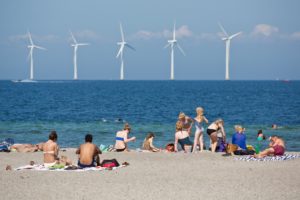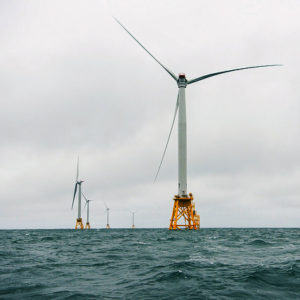Wind power plays a central role for the U.S. in achieving its net zero targets in the next few years. Although the U.S. has seen considerable progress in wind generation capacity, it still trails behind Asia and Europe. A lot of these issues are due to a lack of funding and higher capital costs compared to Europe. Nevertheless, the Biden-Harris administration has prioritized wind power, particularly offshore wind, in America’s net zero strategy.
Key Wind Energy Statistics in the U.S.
- In 2022, wind power accounted for 10% of the U.S.’s utility-scale electricity generation, which totals to around 435 billion kWh.
- Some projections have estimated that wind power will account for as much as 40% of the U.S’s total electricity generation.
- The five states with the highest wind power generation in 2022 were: Texas, Iowa, Oklahoma, Kansas, and Illinois. These states accounted for 57% of the country’s wind power generation.
- Currently, there are two offshore wind power projects operating in the U.S.: the Block Island wind farm off the coast of Rhode Island, with 30 megawatts (MW) of electricity generation capacity, and the Coastal Virginia Offshore Wind pilot project with 12 MW generation capacity
The majority of the country’s wind power potential, however, lies with offshore wind. There are many offshore wind projects underway off the East Coast, where a lot of the potential is. As of the end of 2022, there are projects with a combined power generating capacity of 7,500 MW off the coasts of Maryland, Massachusetts, New Jersey, Rhode Island, and Virgina.
DOE’s initiatives to boost offshore wind: Floating Offshore Wind Shot
In 2023, the DOE established the Floating Offshore Wind Shot, a part of its Energy Earthshots Initiative.. It is an initiative that brings together leaders across all aspects of the offshore wind sector, such as design, research, manufacturing and operations. One of the main reasons offshore wind is more attractive compared to onshore is that it does not take up land, meaning offshore wind is better suited to densely populated areas.
The main objectives of this initiative is to slash the cost of floating offshore wind power by 70% to $45 per megawatt-hour by 2035.
The main issue facing offshore wind today in the U.S. is that a lot of the potential for power generation exists in waters that are too deep for regular offshore wind fixtures.
Typically, in shallow waters, offshore wind platforms are fixed to seabed. However, around 60% of the offshore wind power capacity lies in deep waters. This requires floating platforms that have added technical challenges.

Despite the projected exponential growth of wind in the U.S,, there are still significant economic challenges that need to be overcome. The first and most important one being the soaring cost of raw materials. The prices of steel and aluminum, key materials needed for wind turbine components, have increased in recent years. There is also an over-reliance on imported electronic components from Asia. Some of the initiatives from the DOE aims to boost domestic manufacturing of these components.
Boosting power generation from renewables requires cross-collaboration in the industry between experts, policy makers, and researchers is crucial. New York Energy Week brings together key people in the energy market in various sectors such as finance, government, law, media and academia. Find out some of the ways you can get involved here. NYEW is also hosting key market players in the U.S. energy industry for its decennial anniversary between June 20th to June 23rd 2023.


